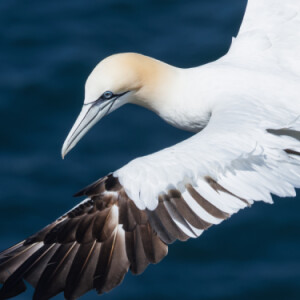Family life
R and I spent the entire day either in and around the RSPB reserve at Bempton Cliffs, or further out along the headland at North Landing and Thornwick. We did eighteen and a half thousand steps, and I took over 600 photos, so I'm spoiled for choice when it comes to potential images for today's post. The two I've chosen both feature Gannets - because, Gannets. What's not to love about a ferocious, predatory seabird, a metre long and with a two-metre wingspan, that yet displays incredible tenderness and respect towards its mate and its offspring?
Northern Gannets, to give them their full common name, are the largest native seabirds in the western Palaearctic region, weighing in at around 3kg. The UK hosts around two thirds of the world's breeding population, because it's a collection of islands, with lots and lots of the inhospitable sea cliffs the Gannet favours. Estimates of the UK breeding population vary from 220,000 to 295,000 pairs, but everyone agrees that there is a slow but steady upward trend. Because of this the International Union for Conservation of Nature considers the Gannet to be a species of least concern, but in the UK, where conservationists are conscious of the fragility of some of its breeding colonies and the dangers posed to the bird by commercial fishing, it remains Amber listed.
The average lifespan of a Gannet is 17 years, and they pair for life. Outside the breeding season a pair will separate, but in the spring they will both return to last year's nest site and renew their pair bond. If one fails to return, the survivor will look for a new partner. The nest is generally about 30cm in diameter, with a depression in the centre, and is constructed from seaweed, floating marine debris (blue plastic rope seems to be quite a favourite), and soil and vegetation from nearby clifftops, mixed with the birds' own droppings. This pair have managed to secure for themselves a highly des-res detached rock pinnacle, but in many places on the cliff the nests are crammed together, with just enough space between them for the owners to stand up and display to each other. As you'd expect, the more closely they're crowded together, the more fights tend to break out between neighbours.
One egg is laid per year (though if it's lost early in the season, it may be replaced), and both partners take turns at incubating it beneath their feet. The black, featherless chick hatches after about 44 days, measuring about 10cm in length and weighing around 80g. It rapidly grows its first covering of white down, and then rapidly grows everything else: by thirteen weeks old it will have achieved adult length, and will weigh around 4kg, which is considerably heavier than either of its parents. The parents alternate the vital duties of guarding the precious and vulnerable youngster and going off to sea to catch fish (mainly herring and mackerel), some of which they hold in a special compartment in their throat and regurgitate for the chick on their return, to fuel that spectacular growth.
Depending on the local availability of food, Gannets may have to travel many miles out to sea to hunt successfully (a 200-mile round trip is not uncommon), and the fishing bird can be absent for two days or more. When they return, the partners immediately renew their bond by play-fencing with their vicious beaks, raising them and tapping them against each other in a display of trust. This done, the partner who has been on babysitting duty will spread its wings and point its bill straight up in the air as a signal to its mate that it's now ready to take its turn at sea, and having satisfied itself that its partner is going to stay, will step carefully away from the chick. The incoming parent immediately moves forward to take its place - a chick must never be left unguarded, especially in the midst of a tightly-packed colony - and the outgoing parent takes off and flies out to sea. Here the male bird on the right was the incumbent, and the newly-arrived female on the left was preparing to take his place.
By thirteen weeks the chick will have its first flight plumage, which is dark greyish brown with white flecks, and its at this point that the adults encourage it to leave home, by the simple expedient of stopping feeding it. After maybe ten hungry days the juvenile will take its maiden flight, aiming for the sea. This is entirely unrehearsed, and can go tragically wrong, but if the young Gannet makes it to the water it will stay there, living on its fat reserves for the first couple of weeks, gradually learning to fly properly, and, crucially, learning the technique and gaining the neck strength to dive and swim so that it can catch its own food. By autumn it will be ready to migrate, and while most adult gannets from the UK winter offshore in southern Europe around the Bay of Biscay, juveniles travel further south, to the coastal waters off West Africa. They don't return to their natal cliffs until they're two years old, and don't breed until the age of four or five - though they do pair up as juveniles, and "practise" nesting on any spare bit of cliff they can commandeer, which is rather charming.
My second image is a flight shot that R particularly likes. It shows how close these birds come to the viewing points along the cliff: I'd managed to wind the zoom in to less than 350mm, but I still had too much Gannet for the frame.
Two recommendations before I go: The book The Seabird's Cry by Adam Nicolson, which manages to be both fascinating and moving; and this short film of the Bempton Gannets by the Yorkshire wildlife artist Robert Fuller.


Comments
Sign in or get an account to comment.


